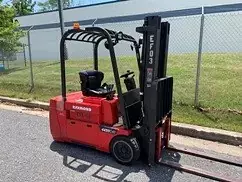 Knowing your fleet is essential to running a successful operation. Knowing exactly what is needed to increase productivity, safety, or efficiency is not always easy though. Some forklifts are great for one job, but not at all ideal for another. Also, the conditions in a warehouse can change as the market changes, and what was once the perfect space can quickly turn crowded as business expands. Here, you’ll find all the information you need to make an informed decision about 3-and 4-wheel forklifts and whether there’s a need for a new or used 3-wheel forklift in your fleet.
Knowing your fleet is essential to running a successful operation. Knowing exactly what is needed to increase productivity, safety, or efficiency is not always easy though. Some forklifts are great for one job, but not at all ideal for another. Also, the conditions in a warehouse can change as the market changes, and what was once the perfect space can quickly turn crowded as business expands. Here, you’ll find all the information you need to make an informed decision about 3-and 4-wheel forklifts and whether there’s a need for a new or used 3-wheel forklift in your fleet.
Difference Between 3-Wheel and 4-Wheel Forklift
The first, and most obvious difference between a 3-wheel forklift and 4-wheel forklift is the number of wheels. However, a 3-wheel model has a much smaller turning radius. This makes them great for small or otherwise crowded warehouses. Similar to a standard counterbalance machine, a 3-wheel forklift is designed with a single drive wheel located at the center rear of the lift. The front wheels essentially drive, while the rear wheel aids in steering and allows the forklift to make tight 90-degree turns. This kind of steering control translates into easy handling.
3-Wheel Lift Offers Quick Handling
If you need quick load handling and management, a 3-wheel forklift is going to be your best bet for maneuvering efficiently around boxes and through narrow aisles. Its generally ideal for rack loading and similar applications, such as what’s needed in most garden centers and building warehouses. The ability to make tight turns generally increases productivity thanks to the combination of counterbalance and under-clearance. The thing to watch out for, though, is load capacity. Generally, a 3-wheel forklift normally cannot have a load heavier than 2,500kg.
4-Wheel Forklift Offer More Lift Power
While 4-wheel machines are generally able to lift more and remain stable on rough, outdoor terrain or inclined surfaces, their higher maintenance costs and larger turning radius are certainly factors to consider when making purchase decisions. Surprisingly, most warehouse forklifts are 4-wheel models, despite the 3-wheel forklift being the ideal choice for indoor use. Also, because they take up less space and cost less to maintain, 3-wheel forklifts are often much more versatile for warehouses.
Your needs change as business ebbs and flows, but whether you’re looking to expand your fleet or simply replace a few older machines, National Forklift Exchange is ready to help match your needs with your warehouse’s budget. NFE offers a range of models and manufacturers from which to choose. Our experts are ready to help you select the best used 3-wheel forklift for your operation, so call today!
